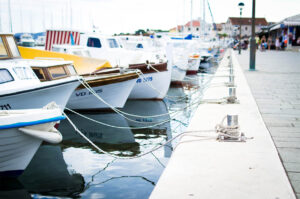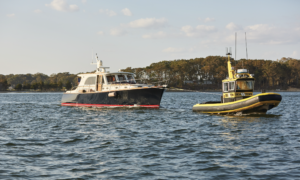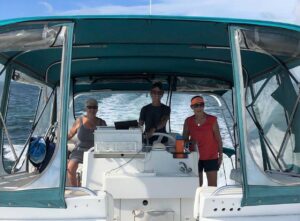Still water is where we all prefer to boat, but wind, current and tide often join forces to produce anything but a calm ride. The motion of a boat on the water can be soothing at times, or it can be quite uncomfortable.
Boats move in three directions. The first is pitching, the upward and downward movement of the boat’s bow and stern, which is sometimes referred to as “hobby horsing.” You frequently notice this during on-coming seas that are spaced close together. Changing the boat’s direction away from the seas by a slight angle can reduce a pitching motion.
The second direction is yawing, which is the movement of a boat rotating around its vertical axis. Imagine the bow and stern swinging side to side in opposite directions. Yawing can happen when a boat moves slowly in confusing seas with waves coming from multiple directions simultaneously. You can reduce yawing by increasing speed slightly, allowing the tracking of the boat’s keel to stabilize sideways movement.
The third type of motion in a boat is rolling, which is the boat’s rocking from side to side (similar to the motion of a baby’s cradle). The shape of the average boat’s hull makes rolling the most difficult motion to stop. Once a rolling motion starts, a reaction serves to maintain or continue the movement. Think of a clock pendulum; once started it only takes a slight input to keep it swinging.
The key to boat stabilization is understanding how to reduce the boat’s movement to a comfortable level. People aboard react to the boat’s motion in different fashions. Some can tolerate it, while others develop seasickness. In recreational boating, many jest about becoming seasick, but it can be quite serious. If you ever experience seasickness, you appreciate the effort and engineering that goes into boat stabilization.
METHODS OF STABILIZATION
Boat designers and equipment manufacturers primarily focus on eliminating roll in a boat, because individuals at the helm can’t really stop it, and it is probably the most uncomfortable of the three motions to experience. In recreational powerboats, two commonly used methods reduce a boat’s rolling motion: passive and active stabilization.
Passive stabilization is achieved through hull design. Naval architects design broader flatter sections at the stern with hard chines or small bilge keels extending from the hull at or near the chine-break.
This method depends on the fixed hull sections to create resistance against the water to minimize roll. Sailboats utilize a form of passive stabilization through their keel and sail. Devices that sense the rolling motion and initiate an active counter- reaction to reduce the motion achieve active stabilization. Within the active category, the two most common are gyroscopic and rotational fin stabilizers.
In either case, successful stabilization depends on stopping the roll before it begins, because once the roll starts physical forces act to continue the roll.
Gyroscopic Stabilizers consist of a flywheel spinning inside a chamber. The gyroscope chamber is secured to the boat’s framing in an open space below deck. When highly sensitive devices within the gyroscope perceive a rolling motion, the gyroscope quickly pivots either fore or aft, creating a sideways torque in the opposite direction of the roll, thereby reducing the roll. The size and number of gyroscopes can vary depending on the boat’s length and weight. They can stabilize boats as small as 27 feet long and as large as 85 feet with a single unit. Larger vessels can have multiple units installed to achieve satisfactory results.
Many see gyroscope stabilizers as new technology, but they date back more than 100 years. Gyroscope stabilizers were installed in the USS Henderson, a World War I transport ship launched in 1917. Tests proved that gyroscopes could limit roll to three degrees in the roughest seas.
Active Fin Stabilizers are foil-shaped fins that extend from the hull sides underwater. Similar to gyroscopic stabilizers, active fin systems have sensors that detect any rolling motion. The fins, which are mounted on thru-hull shafts, rotate to counteract the roll. The rotors controlling the fins are typically hydraulically actuated; however, electronic and pneumatic versions are available.
Each fin stabilizer company offers features in the design and shape to make their product unique and provide the best performance. The comparison is similar to an airplane wing design, and different shapes can achieve the same results. Also like the gyroscopic stabilizers, active fin systems are available in different sizes to accommodate various size boats.
Gyroscopic and active fin stabilizers can be designed into most new boats. The ability to retrofit into an existing boat depends on a variety of factors including weight, available space and hull shape.
Without successful stabilization, the rolling motion in a boat can be
uncomfortable or even dangerous. Properly designed and installed stabilizers in a boat make a remarkable difference. It’s like having the captain say, “The seatbelt sign has been turned off. You are now free to move about the boat.”




